
MY JEZZ PROFILE
Submitted
by Judi Wright in March 2001
I started playing JezzBall about 6 years ago. I can remember the first time I reached a score of over 1 million. It was such a big milestone that I there and then decided that it was impossible for me to have a greater score.
It
was only about twelve months ago that I discovered this wonderful website and realized
that my score of 1.4 million was rather pathetic.
I thus set about learning some more techniques and a couple of weeks ago
was on my way to stardom with a score of 7,699,128 when I decided I should
really do some work and copy several important documents.
I paused JezzBall to complete  my
“more important” tasks. However,
just as I was finishing the last page the program seized and the computer
refused to open anything!! The only chance of recovery was to press Ctrl-Alt-Del
which usually allows you to close down the offending program.
Not so this time – nothing would work.
The only possible solution was to again press the dreaded
Ctrl-Alt-Delete. The computer
‘obligingly’ closed down everything along with my incomplete JezzBall!! Just as a good rider gets back on the horse after a
fall, a few days later I again faced the challenge and reached, for me an
incredible total of 9,250,844
my
“more important” tasks. However,
just as I was finishing the last page the program seized and the computer
refused to open anything!! The only chance of recovery was to press Ctrl-Alt-Del
which usually allows you to close down the offending program.
Not so this time – nothing would work.
The only possible solution was to again press the dreaded
Ctrl-Alt-Delete. The computer
‘obligingly’ closed down everything along with my incomplete JezzBall!! Just as a good rider gets back on the horse after a
fall, a few days later I again faced the challenge and reached, for me an
incredible total of 9,250,844
Jezz is a relatively new interest for me. For the past 20 years my life has revolved around the world of contract bridge. I have been involved with this fascinating game in all aspects having reached a personal playing rank of Grand Master. In Australia this is a total of 1,000 master-points 70% of which must be obtained in National or highly rated competitions. After having achieved this major goal I now only play a dozen or so games a year.
Some 15 years ago I began teaching bridge and subsequently founded several bridge clubs. I have received a great deal of satisfaction in bringing the joys of the game to so many people. Many of my students were those who needed a new interest in their lives and now find that they are enjoying the company of like minded folk four or five times each week. From teaching and running bridge clubs I naturally developed the skills required to become a Bridge Director, and until recently have been running tournaments in various towns in N.S.W.
I have written many bridge books for my beloved beginners as well as one which has become the accepted reference book for Directors of club competitions. In 1999 the New South Wales Bridge Association appointed me as the State Master-point Secretary – a job I really enjoy as it brings me into contact with each of the 145 clubs in our state.
MY
TECHNIQUE
For what it is worth I would like to tell you of the way I attempt to play JezzBall. Although I have tried and tried to master the technique of centring on a ball described by other contributors to this website, I have failed miserably. My technique costs lives unless I manage to draw a “free” channel. I rarely use vertical channels preferring to capture the balls in horizontal traps.
These are very useful in the early levels and in later levels when there are only a few balls remaining.
A free horizontal trap on the LHS of the grid can be drawn whilst another horizontal line travels across the entire grid.
Place the arrowhead on the bottom (or top) line, somewhere well to the left of the center of the grid. Whilst the line is extending to the right, start a new grid somewhere fairly close to the left hand side, above or below the line which is travelling to the right. Of course, with only a few balls remaining, you can be more daring and achieve a longer trapping channel.
A free horizontal trap on the LHS of the grid can also be drawn whilst a vertical line, started near the top of the grid, moves towards the bottom.
In the latter part of a game this will usually work best in a separate section of the grid. To make a separate section you will need to trap a ball, but not cut if off. That way you may be able to place a vertical line some distance from the trapped ball and give yourself an area to utilize for the purpose of drawing vertical lines and at the same time inserting “free channels” in the main grid.
Free horizontal traps on the RHS are drawn whilst either:-
a
horizontal line, started well to the right of the center, moves to the left, or
a
vertical line, started near the bottom of the grid,
moves from the bottom to the top.
A LHS channel 3 lines from the bottom was formed whilst the far left hand column was cut off from top to bottom. It was of course vital that the remaining balls were well out of the way. A ball must then be trapped in this channel.
Next, a vertical column was placed several columns to the right of this channel to form two separate sections of grid. You will then have something similar to the screen shot below.
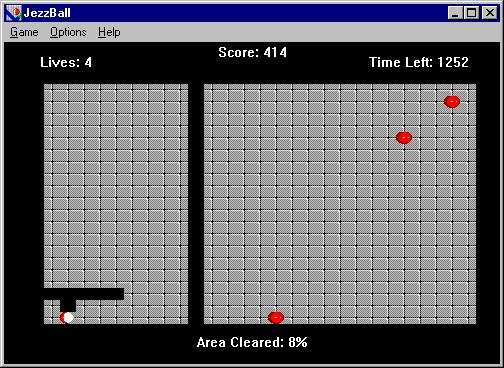
The next step would be to use the LH section to draw ‘unhindered’ vertical lines and whilst they are still advancing, place horizontal traps on the main grid. Remember if the vertical line starts at the top, the horizontal grid must be on the LHS. Plenty of opportunities exist in the early levels to practice this technique.
I do not believe you should worry too much about your results on the early levels, but of course you do try to lose as few lives as possible. By the time you reach level 25 (for me about 2 million) you will find that your first LH channel might consist of only 1 or 2 spaces, which will then be gradually extended as balls are trapped. The channel across the bottom has to be taken slowly with quite a substantial loss of life. As the number of balls decrease you will of course be able to create longer traps. I try to continue each channel across the bottom and then start a second channel above it.
I believe the whole secret of success (which I certainly haven’t mastered) is to be patient, don’t be greedy, take great care and NEVER draw a quick channel because you are annoyed with your previous attempt to draw the same channel. This latter weakness usually results in disaster! Very seldom is the time limitation going to be a worry so TAKE YOUR TIME.
From
about level 34 I start to draw a series of small horizontal channels – 7 down
the LHS and 4 down the RHS. I wait
until about half the balls are trapped (at level 49 the most I can trap will be
22 but the remaining balls ‘flying around’ are quite manageable).
The excess space is removed whenever convenient, and any side channels
not filled can be used to catch another two balls.
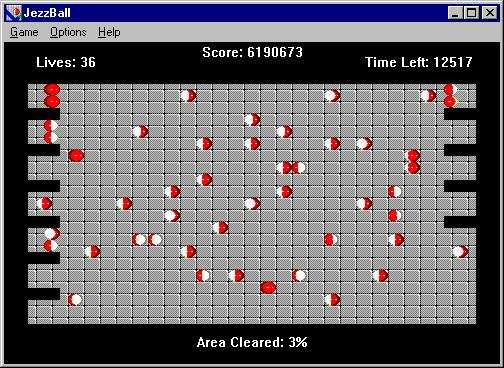
After
the balls have conveniently trapped themselves, I draw a horizontal channel
along the bottom from the RHS, catch one or two balls and extend the channel
gradually.
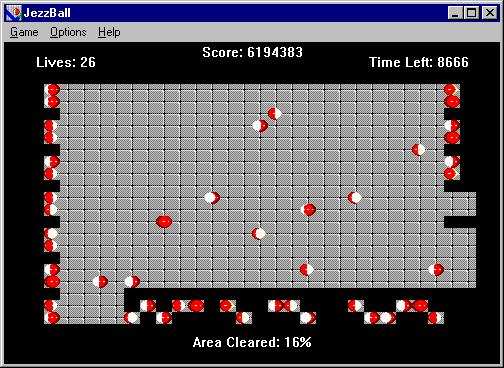
When the bottom channel is complete I start a second channel above it. Under ideal conditions most of the balls can be trapped in these channels and I then set about creating a separate section to enable me to make “free channels” to catch the last few balls. The separate section on the RHS has been used for verticals allowing me to draw two RH channels on the main grid section.
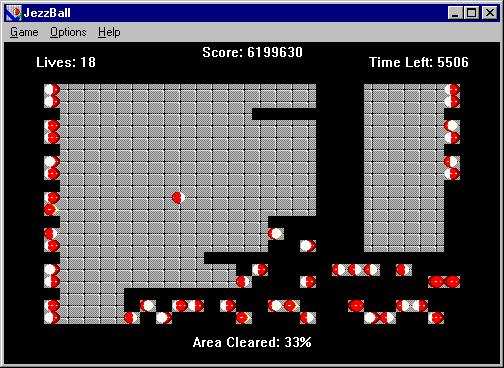
At
last all the balls are trapped and all that remains is to remove the excess
cells. Of course you need to do
this systematically as ideally you trim until no more than 74% remains, then cut
the last ball clearing the entire remaining area resulting in a score of over
90%. In the example below you will
need to clear the excess from the two separate sections on the left and right.
Then cut the main grid horizontally 7 rows from the bottom.
Clear all the excess from this bottom section.
Then clear the top ball to achieve the maximum clearance.
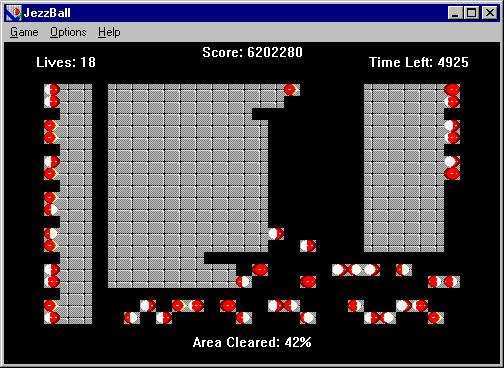
These 4 Screenshots were all taken from Level 47 and resulted in a final score on that level of 6,497,476 with 18 lives left.
Have fun – that’s what its all about.
Please feel free to email me: judi@tsn.cc
![]()
Also see my thoughts on personal Web Etiquette and You.
and: